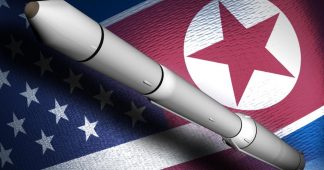Climate scientist Michael Mills describes the devastation of a nuclear detonation
People get “melted into burning pools of fat”
By Bryan Dyne
Nearly three years ago, the World Socialist Web Site published a Perspective that posed the question “Are you ready for nuclear war?” At that time, the United States government was accusing the Kremlin, without any evidence, of shooting down Malaysian Airlines Flight MH17. As a result of these provocations, tensions between the United States and Russia rose to heights unseen since the Cuban Missile Crisis of 1962.
Tensions globally are even greater today. By directing the naval strike group led by the USS Carl Vinson aircraft carrier and the USS Michigan nuclear submarine to the Sea of Japan, the Trump administration has escalated the already acute confrontation on the Korean Peninsula. Through these actions, Washington is provoking a conflict that could draw in nuclear-armed China and Russia, both of which have borders with North Korea.
Such a war threatens the nearly 76 million people who live in North and South Korea. It also has a high potential of involving the 127 million people who live in Japan, which would be in the direct line of fire of any war with North Korea. What goes unmentioned by government officials of the US and its allies—much less the corporate media—are these millions of people who are likely to die in a war between the US and North Korea, particularly if nuclear weapons are used.
The devastation of a nuclear war on the Korean Peninsula would not be a regional affair, but a direct threat to the entire ecosystem of Earth. As part of our continuing discussion with scientists and experts on the threats posed by nuclear war, the World Socialist Web Site spoke with climate scientist Michael Mills, who has studied the climatic effects of nuclear detonations for nearly a decade. As part of his work at the National Center for Atmospheric Research and on the Atmospheric Chemistry Observations and Modeling team, he has looked at how nuclear weapons can create firestorms, turning whole cities and their inhabitants into nothing more than ash, soot and debris.
* * *
Bryan Dyne: What would happen to a city in a nuclear exchange between the US and North Korea?
Michael Mills: Our work is based on the idea that if a nuclear bomb exploded over a large modern city, the explosion would cause fires that would ignite over the entire area, eventually becoming what is known as a firestorm. This means that the fires have become so hot that the city itself becomes fuel for the fire, which releases much more energy than the nuclear weapon itself. This is what happened during the incendiary bombings of Hamburg, Dresden and Tokyo and the atomic bombing of Hiroshima during World War II.
Essentially, if a city is ignited on this scale, the fires produce millions of tons of black smoke, also called soot, from the burning buildings and other materials. Heat from the fires causes the soot-filled air to rise, and the soot absorbs sunlight, further heating the air so that it rises into the stratosphere, 10 to 30 miles above Earth’s surface. These particles are so high that they don’t get rained out, since there is no weather in the stratosphere. So it can take decades for the soot to settle back down to the surface.
The main effect from all this soot being trapped in the stratosphere is that it continuously absorbs sunlight. In our models, which are based off of the detonation of 100 small nuclear weapons by India and Pakistan, global temperatures become the coldest they’ve been in the past 1,000 years. In a big exchange between major powers, you basically get ice age temperatures.
The second problem is that heating up the stratosphere destroys up to 50 percent the ozone layer by producing changes in the chemical reaction rates that produce ozone. While this happens today in Antarctica, that is a seasonal effect that occurs in the Antarctic spring and early summer. The loss of ozone from stratospheric heating is constant and worldwide. As a result, crops and ecosystems face not only freezing temperatures, but also intense ultraviolet light from the Sun as a result of a diminished ozone layer.
This research is not something that I’ve ever been funded to study. I’ve been able to pursue this in my spare time because I work on models of atmospheric chemistry and climate and it seemed like a very important issue to me.
I usually work on the climatic effects of particles from volcanoes, which are liquid droplets that tend to scatter light rather than absorbing it. They have a similar cooling effect in that after a volcanic eruption, these droplets are ejected into the stratosphere and reflect sunlight away from Earth. But the black absorbing smoke particles are much more effective at the same thing. They have a bigger effect on the Sun’s radiation than the volcanic particles.
BD: What’s the significance of using a model of a nuclear war between India and Pakistan?
MM: The initial motivation for our recent studies is that we wanted to revisit the nuclear war studies that were done in the 1980s, using the vastly more sophisticated climate models that had been developed since. So Alan Robock looked at impacts of a war between the US and Russia using a NASA climate model.
But we also wanted to look at the increasing number of new nuclear powers and their expanding arsenals. The India-Pakistan scenario served to show that even relatively small nuclear weapons can have a global effect. In 2007, when I was working on this with Brian Toon, each country had only about 50 Hiroshima-sized weapons each, the smallest nuclear weapons in existence. Even an exchange with these weapons, which are much smaller than those used by the US, Russia, Britain or France, can still cause global planetary environmental damage from the smoke that’s released.
Brian Toon was trying to get the people in the military interested in paying attention to this issue. The United States has a current arsenal of about 1,700 nuclear weapons. It’s difficult to justify having so many because even if you used them and no enemy retaliated, you would suffer from the global effects.
BD: In that vein, is there such a thing as a ‘limited nuclear war’?
MM: We obviously had a ‘limited nuclear war’ in World War II when the US used its entire stockpile of nuclear weapons, which was two. Given the number of weapons that now exist, however, once you start using them you quickly reach a point where you are producing so much damage to millions of people. And then there are the smoke effects, which damage the whole planet. I think people in charge of making military decisions need to be well aware that the idea of a ‘limited nuclear war’ is a very dangerous concept.
BD: Could you go a bit more into the science of how the cities are turned into smoke?
MM: The firestorm was something that the Allies intentionally devised in World War II in raids against Hamburg, Dresden and Tokyo, with many, many incendiary bombs designed to ignite fires close to one another. When you have fires all over a city, they tend to join together and intensify, creating temperatures so hot that even asphalt and concrete become fuel. That’s where the black smoke comes from.
As we saw with Hiroshima, when you detonate a nuclear weapon in the air above a city, it has the same effect of igniting fires all over the city.
The heat from the fires then acts like a thunderstorm, lifting air up very quickly. This means that air has to come in from below to replace it. So from all directions, air gets sucked in, adding more oxygen to the fire. Moreover, the air is so fast that it carries with it debris, animals and even people.
To quote from the book Fire and Ice by David Fisher:
“On July 27, 1943 nearly a thousand British bombers dropped over two thousand tons of bombs on Hamburg, most of them incendiaries, turning that city into a burning, melting quagmire of horror. The temperature reached one thousand degrees in the center of town, igniting the world’s first firestorm. The superheated air rose so fast it sucked in outside air in the form of hurricane-strength winds, which force-fed the fire still further and blew helpless people like leaves into the burning center of destruction where they actually melted into pools of burning fat. On the outskirts of the storm other people were stuck in molten asphalt, suffocating and igniting. More than 40,000 people died that night. In the early spring of 1945 the American Twentieth Air Force topped the RAF’s record by burning Tokyo, starting a conflagration that totaled sixteen square miles of intensely populated city, killing more than 80,000 people.”
BD: Are the fires something that can be started by radioactive fallout or is it just the initial explosion of the bomb?
MM: There are two kinds of ways of dropping a nuclear bomb over a city: there is an airburst, where it explodes high, and there is a ground burst, when it explodes when it hits the ground. Airbursts are most effective at creating firestorms, igniting cities. And it’s much more widespread damage than a ground burst. Ground bursts are what create fallout, which is when it sends up material from the ground that is radioactive, which can spread in the wind. There would be more fallout from a ground burst, and more fire from an airburst.
BD: What would the world look like after a nuclear exchange between the US and China?
MM: In that case, you’re talking about two powers with very large stockpiles of nuclear weapons. You could get a tremendous amount of smoke if you started dropping bombs in cities across the US and China. That’s the sort of thing that Alan Robock modeled in a US/Russia war.
It’s what we call a true nuclear winter, in the sense that in some places in the interior of continents, for example in Ukraine, the temperatures remain below freezing all year long, so you can’t grow crops at all under those conditions. Similar things happen in the center of the US and China. On all continents, basically. You have global average temperatures that get basically as cold, for a year or so, as what we had in the last ice age.
BD: What would happen after the first year?
MM: When we modeled an India/Pakistan war in 2014, we found that when you include interactive components in your model, such as the effects of the full ocean, expanding sea ice, that the changes to climate are more prolonged. This is largely thanks to the ocean’s ability to store lots of heat. Although global temperatures cool more slowly when one considers the ocean, the lower temperatures are more prolonged.
After 24 years of our simulation, temperatures were still below normal, whereas in other studies that didn’t include the full impact of the oceans, they showed that the temperatures had recovered in ten years. And this is a small nuclear war.
It’s really hard to say how much destruction something like this would cause, how many species would be wiped out and if ours would be among them or not. What I’ve studied shows that even a small event could cascade. We’ve seen food shortages in the past few decades that have been intensified by societal reactions. There was a global rice crisis in 2008 after India and Vietnam stopped exporting rice, for example, leading to a severe shortage in the Philippines and food riots in Haiti. Certainly food shortages have been tied to uprisings in the Arab Spring. So all sorts of things could happen that are destabilizing.
But with a large war, it’s somewhat unknowable, but also so horrific it doesn’t matter exactly how damaging it is.











